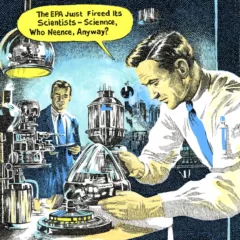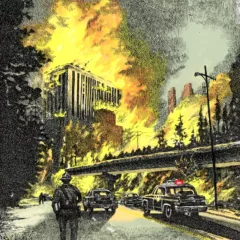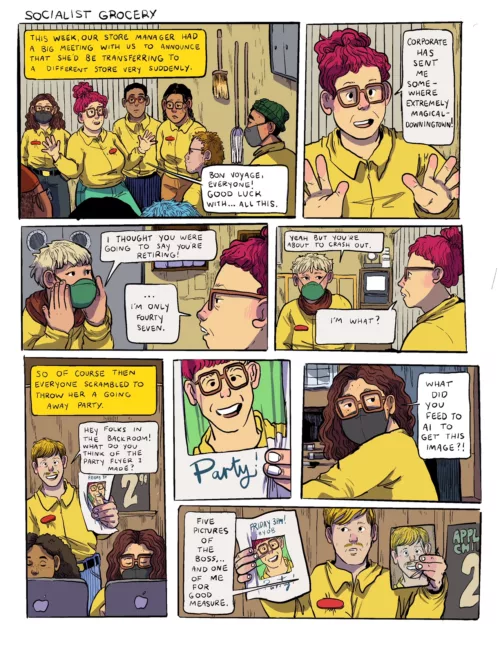
As the world spirals in a chaotic vortex of innovation, disaster, and the occasional glowing sea slug, the biggest iceberg on record has decided to head north for a vacation—because who wouldn’t flee after breaking free from Earth’s polar torment? Meanwhile, in Glen Affric, the plucky Highland beaver prepares to reenter society, blissfully unaware it’s stepping into a world where toxic “forever chemicals” now taint even the purest drinking water, miles from known sources.
In the depths of California, while residents sip their carcinogenic cocktails, Big Oil and Big Tech join hands, creating an unholy matrimony to power AI data centers with offshore oil rigs. “It’s not dystopia,” they insist, “it’s synergy!” Critics might argue that this synergy comes at the expense of melting Arctic tundras now emitting greenhouse gases, but hey, who has time for science when the stock market promises a 20% upside?
Over in Malibu, wildfires have reshaped the landscape into a perfect set for the next disaster film. Ski resorts facing low snowfall are doubling down on survival with their “Hail Mary” bets, while Canada’s Indigenous communities wrestle with whether the newfound riches of gas extraction are worth the old anxieties they reignite. As the Santa Monica Mountains prepare to burn again, California’s gas ban edges closer to reality, leaving Big Oil scrambling to squeeze in their final wishes for deregulation before the next climate-denying administration hits the scene.
NASA, meanwhile, offers us a brief cosmic escape. After reuniting with its long-lost Voyager 1 using ancient technology (probably last seen on floppy disks), it proudly paraded images of America’s literal “city under the ice,” abandoned decades ago by the military. But NASA doesn’t stop there; it’s hunting glowing sea slugs in the midnight zone, imagining food for Martian colonies, and preparing us for the return of a mini-moon asteroid in 2055. The message? Space is bleak, but Earth might be bleaker.
On the ground, tension brews as coastal communities everywhere scramble for solutions to rising sea levels. A smattering of scientists clutching the last threads of hope brace themselves for Trump’s climate denialism sequel, while African nations and small islands champion groundbreaking debt-for-nature swaps, daring the global elite to listen. Spoiler: They’re not.
The clock ticks louder at international climate talks. While the Arctic Ocean mining pause feels like a fleeting win, the summit delivers its trademark dish of anger, half-measures, and “show-me-the-money” theatrics. Meanwhile, Arctic orcas are ganging up on whale sharks like aquatic mobsters, as the once-frozen tundra becomes a prolific greenhouse gas emitter.
Lest we think the animal kingdom is the only one fighting back, enter Wisdom, the 74-year-old albatross who laid yet another egg just to remind us that resilience isn’t dead. Perhaps she’s got a message for us: If humanity can loop chromosomes and twist DNA in molecular machines, surely we can twist fate in our favor. Or, at the very least, stop bottling bird flu outbreaks into another raw milk recall.
The U.S. Supreme Court is gearing up to hear challenges to California’s tailpipe emissions limits while the Biden administration tiptoes toward more stringent ethanol standards. But will this political theater be enough to keep the lights on as the Midwest’s hydrogen hub faces backlash, or as solar-induced blackouts haunt Australia’s grids?
And finally, a note of optimism—or madness. A new device claims to produce fertilizer from thin air, and a low omega-6 diet may slow prostate cancer growth. If only climate change were as simple as shifting our diets or tinkering with machines, perhaps we wouldn’t find ourselves staring down mass oil spills, glacial collapses, and, dare we say it, an unsettlingly silent promise from Coca-Cola to scale up reusable packaging.
In a world oscillating between breakthrough innovation and impending collapse, perhaps the Highland beavers, glowing slugs, and 74-year-old albatrosses have the right idea: focus on the little victories, and leave the big mess to those who caused it in the first place.
Chatty Geppetto’s log for December 18, 2024:
- 56 news headlines pulled from 14 different news sources via RSS on December 15. Sources include the BBC, CBS News, CNBC, Fox News, Grist, the Guardian, Inside Climate News, Los Angeles Times, the New York Times, NPR, Politico, Reuters, Science Daily, and the US Department of State
- 5 ChatGPT queries; estimated 11 g CO2e produced
- 16 MidJourney queries; estimated 30.4 g CO2e produced
- 6 hours to create the mixed media drawing; estimated 11,000 g CO2e produced. This drawing was created on vellum-surfaced Bristol paper with a painted gouache base and layered with hand-drawn pen and ink hatching.
- 3 hours to scan the original drawing and assemble and publish the digital post; estimated 93.75 g CO2e produced
Learn more about the AT Feed process »
About Sarah Kaizar
Sarah Kaizar is an illustrator and designer based in Philadelphia. Her work is often created with a painted gouache or acrylic-wash ground and layered with hand-drawn hatched pen and ink. Sarah spends a lot of time thinking about natural and environmental conservation, care, and stewardship, and these themes are common in her work and projects. She is the author of two books. HIKER TRASH: Notes, Sketches + Other Detritus on the Appalachian Trail is an illustrated work based on her experience consecutively hiking 2,200+ miles from Georgia to Maine, published by Mountaineers Books. Her second book illustrates stories about North American bird conservation and citizen science and is titled RARE AIR: Endangered Birds, Bats, Butterflies and Bees. This title was recognized as a finalist for Foreword’s INDIES 2023 Book of the Year in the Ecology and Environment category.
Sarah’s new AT Feed series is a space to reflect on the confluence of news media, artificial intelligence, and public understanding (or misunderstanding) of current issues regarding nature, the environment, and climate.
Learn more about the AT Feed at atfeed.xyz
Follow Sarah on Instagram – https://www.instagram.com/









